Ever wondered why indoor gardeners often struggle with lavender plants? Is it really hard, or are there secrets to growing them well? We’ll share key tips for growing indoor lavender. These tips will help you get vibrant blooms and lovely scents in your home.
With over 450 varieties, you can pick the perfect lavender for your space. It not only beautifies your home but also adds a calming scent.
Starting indoor lavender can seem tough, especially with seeds. But, using potted plants or transplants makes it easier. You’ll discover what your indoor lavender needs, from light and water to temperature and soil. Whether you’re new to gardening or experienced, these tips will help you grow a beautiful indoor lavender garden.
Table of Contents
Understanding the Benefits of Indoor Lavender Plants
Indoor lavender plants bring many benefits to your home and health. They have a calming scent that helps reduce anxiety and stress. This scent can also ease headaches.
Having lavender indoors means you can enjoy fresh flowers all year. It adds beauty to your home and a natural fragrance. Plus, it’s easy to care for and works well in most climates.
Lavender is great for keeping pests away, like mosquitoes and ticks. It’s perfect for homes that value comfort and safety. It also attracts bees and butterflies, boosting your indoor space’s biodiversity.
Lavender has many uses beyond its beauty and scent. You can use it for DIY projects like making sachets, candles, or bath products. Discovering the benefits of indoor lavender reveals a plant that beautifies and supports a healthier lifestyle.
The Best Lavender Varieties for Indoor Growing
Choosing the right lavender for your indoor garden is key for healthy growth and lovely blooms. Look for compact varieties that fit well in pots.
Here are some popular indoor lavender types:
- Goodwin Creek Grey: This fragrant indoor lavender does well in homes, best for zones 7 and above.
- Munstead: A dwarf variety with a compact size and rosy purple flowers, great for indoor spaces.
- Little Lottie: It has soft pink flower spikes, adding a gentle touch to your space.
Other good indoor lavender types include French lavender (Lavandula dentata), Canary Island lavender (Lavandula canariensis), and fern leaf lavender (Lavandula multifida). These varieties do well indoors, offering lovely scents and attractive foliage.
When growing a potted lavender, choose a container just a bit larger than the root ball. Make sure the pot has holes for drainage to prevent waterlogging. A light potting mix with sand, perlite, compost, and lime helps with drainage, which is crucial for lavender health.
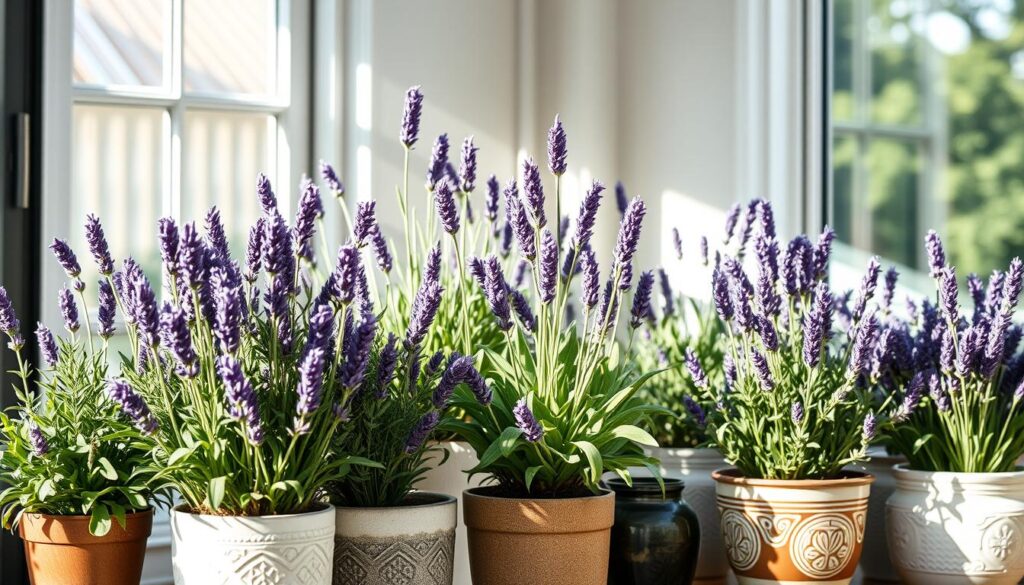
With the right care and attention to each lavender’s needs, you can create a thriving indoor lavender garden that lasts for years.
How to Choose the Right Container for Your Indoor Lavender Plant
Choosing the right container for indoor lavender is key for its health. A container for indoor lavender needs to drain well and breathe. Terra cotta, clay, or ceramic pots are great because they let moisture escape.
When picking choosing pots for lavender, make sure it’s at least 12 inches wide. This size helps roots grow and gives room for the plant to expand. Also, check that the pot has many drainage holes. This is crucial to prevent root rot, a common problem.
- Opt for pots made of unglazed materials for better airflow.
- Repot your lavender annually to refresh the soil.
- Consider using a mix of potting soil with perlite or coarse sand to enhance drainage.
To keep your potted lavender healthy, choose a container that lets it grow and drains well. The right container is essential for your indoor lavender’s success.
Essential Light Requirements for Growing Lavender Indoors
Growing lavender indoors needs careful attention to light requirements for indoor lavender. These plants do best with 6 to 8 hours of direct sunlight daily. A south-facing window is perfect for your lavender, giving it bright, direct light.
If natural light is not enough, use full-spectrum LED grow lights. They help mimic natural sunlight. This helps your lavender grow well and boosts its fragrance and oil.
Lavender needs sunlight to stay strong and healthy. Without it, they can become weak and spindly. To help them grow, rotate your pot weekly. This ensures even light and promotes lush foliage.
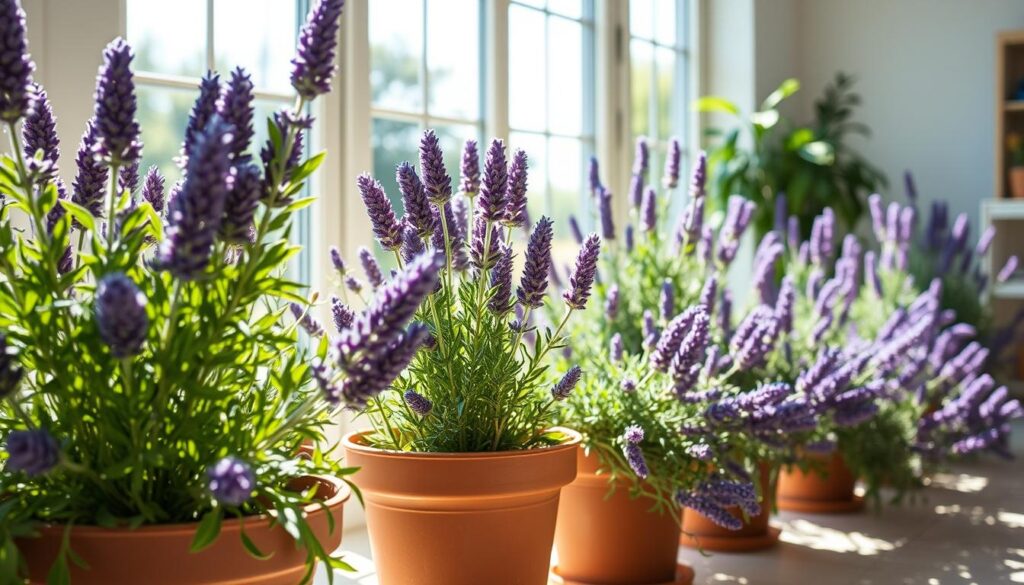
In short, knowing your lavender’s light needs is key to growing them indoors. Good sunlight is essential for their health and blooms.
Optimal Temperature and Humidity Levels for Lavender
To grow indoor lavender well, knowing the right temperature and humidity is key. Lavender likes temperatures between 60 to 85 degrees Fahrenheit. The best daytime is 60 to 70 degrees, and nights should be about 10 degrees cooler.
Keep your lavender away from cold drafts and direct heat. This helps it grow strong and healthy.
Humidity is also important for lavender. It does best in low humidity, between 20% and 35%. This stops root rot and other problems from too much moisture. If your air is too humid, a dehumidifier can help.
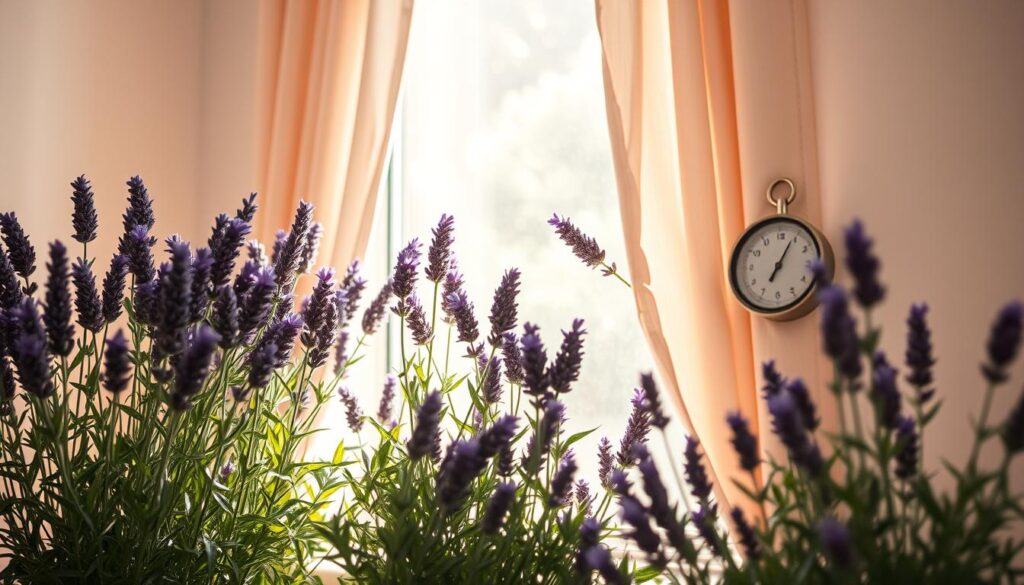
It’s also important to water your lavender right. Let the soil dry out a bit between waterings. This keeps the roots healthy and the plant strong. With the right care, your indoor lavender will bloom beautifully, adding color and scent to your home.
Indoor Lavender Plant Care: Watering Guidelines
Watering your indoor lavender is key to its health. Knowing how to water it right helps it grow well and avoids problems. Water the plant well, making sure the water gets to the roots. Let the soil dry a bit before watering again.
Too much water can cause root rot. Not enough water can turn the leaves yellow. To know when to water, try the finger test. Stick your finger into the soil. If it’s dry, it’s time to water.
Keep a watering schedule that fits your home’s conditions. Following these tips will help your indoor lavender do great.
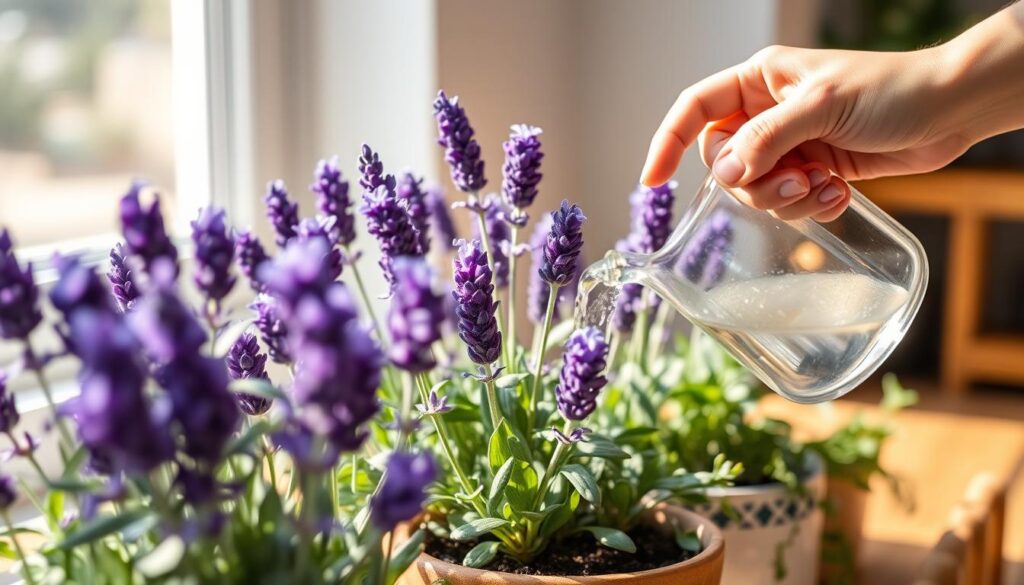
- Water thoroughly and evenly.
- Let the top inch of soil dry out before re-watering.
- Check moisture levels with the finger test.
- Avoid water-logged conditions to prevent root rot.
By being careful with watering, your indoor lavender will stay healthy and vibrant. With the right care, it can even thrive indoors.
Soil Requirements for a Thriving Indoor Lavender Plant
To grow the best soil for lavender, use well-drained, slightly gritty soil. This keeps the roots healthy by avoiding moisture. Mix quality potting soil with cactus mix or sand for the perfect texture.
Stay away from heavy clay soils, as they hold too much water and can cause root rot. Adding perlite or pumice to your soil helps it drain better. This keeps the soil light and healthy for your plant. Make sure the soil pH is between 7.0 and 8.0 by adding crushed eggshells or lime.
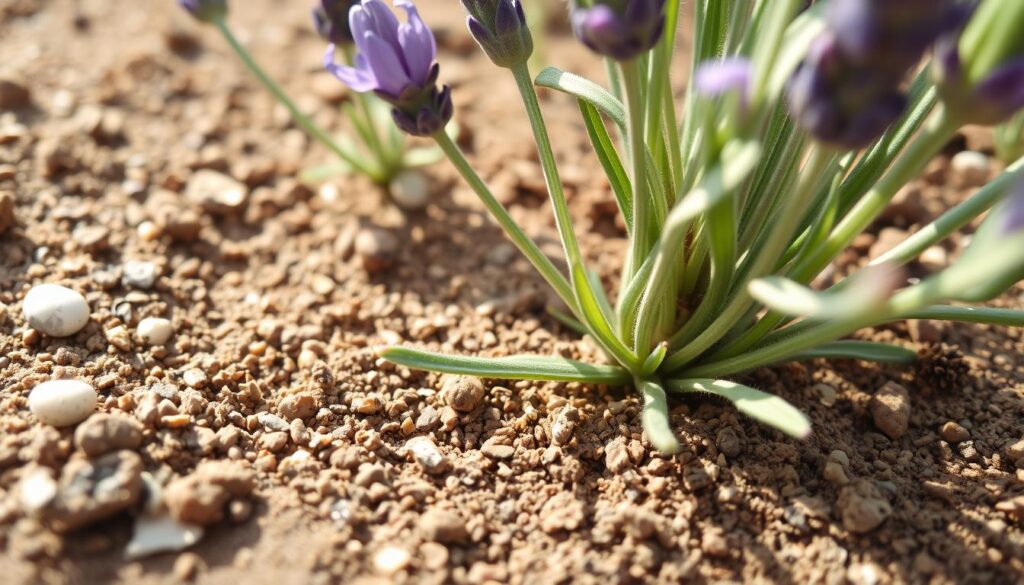
By following these steps, you’ll have the best soil for your indoor lavender. Keep an eye on the moisture and adjust your watering schedule. This will help your lavender plants thrive.
How to Fertilize Your Indoor Lavender Plant
Fertilizing indoor lavender is key for healthy growth and vibrant blooms. Spring and summer are the best times to feed your plants. Use a balanced, water-soluble fertilizer at half strength every four weeks.
Too much fertilizer can harm your plants. It can cause nutrient build-up and even root rot. Instead, choose a slow-release, organic fertilizer like seaweed or bone meal. Apply it once a year in the spring for balanced nutrition.
Don’t fertilize in the fall and winter. This is when your lavender needs to rest. By following these tips, your plants will stay healthy and bloom beautifully.
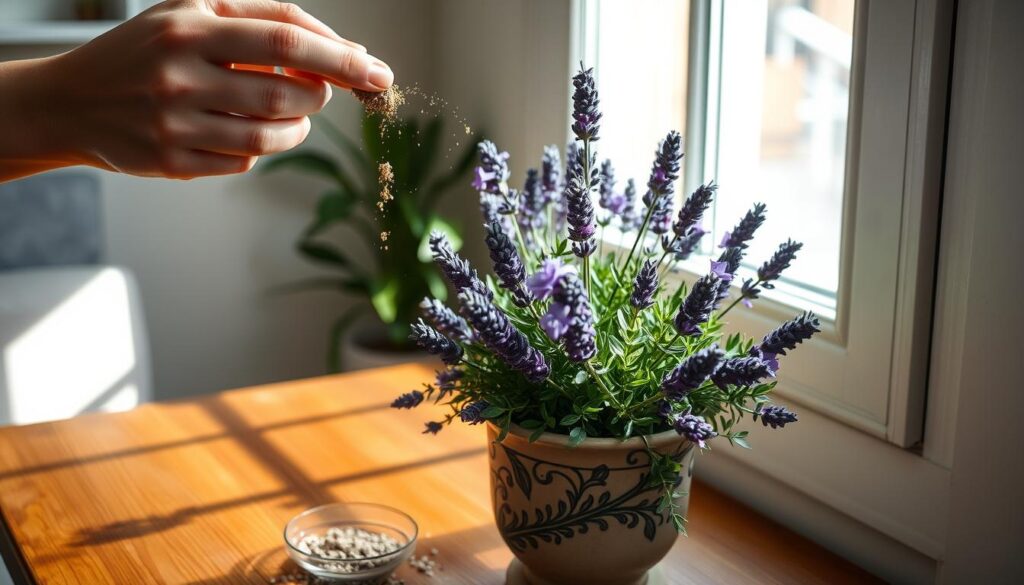
Indoor Lavender Plant Pruning: When and How to Do It
Pruning indoor lavender is key to keeping your plants healthy and looking good. Regular care makes them bushier and stops them from getting too long. Prune in the spring after the first bloom and again in the fall after the last flowers.
To prune your lavender right, follow these lavender plant care tips:
- Cut back about one-third of the plant’s height, focusing on the green, leafy growth.
- Avoid damaging the woody parts, as these are essential for the plant’s structure.
- Tip prune occasionally to encourage fuller growth, but be cautious as constant tip pruning may impact flowering.
Knowing how to prune lavender plants correctly will make your blooms and foliage vibrant all season. With these tips, your indoor lavender will thrive and add beauty to your home.
Common Pests and Diseases Affecting Indoor Lavender Plants
Indoor lavender plants add beauty to your home but face pests and diseases. Knowing the common pests helps keep them healthy. Spider mites, aphids, and mealybugs are common in indoor settings.
Keeping your plants clean is key to managing pests in lavender. Regular checks help spot problems early. Clean leaves and ensure good air flow to prevent diseases like root rot.
Fungi like Phomopsis lavandulae and Septoria lavandulae can harm your plants. Root rot from too much water is a big problem. Good soil conditions help avoid these issues. Also, the Alfalfa Mosaic Virus can spread through insects or dirty tools, showing the need for clean gardening.
- Regularly monitor for signs of pests such as spider mites and whiteflies.
- Use insecticidal soap or neem oil for infestations.
- Practice good watering habits to reduce the risk of root rot.
- Keep the growing area free from debris to deter diseases.
- Implement Integrated Pest Management (IPM) for a holistic approach to pest control.
By following these steps, you can keep your indoor lavender plants healthy and beautiful. Paying close attention to your plants will help you manage pests and diseases effectively.
How to Transition Indoor Lavender Plants Outdoors
Transitioning lavender outdoors is rewarding. Start by slowly getting your indoor lavender used to the outdoors. Begin by leaving it outside for a few hours a day. Gradually increase the time over a week to help it adjust.
Make sure all frost danger has passed before moving your lavender outside. This protects it from sudden cold.
Lavender loves full sunlight, so pick a sunny spot in your garden. It also needs well-draining soil. Mix potting soil with cactus mix for the best soil.
After moving your lavender outside, watch the soil moisture closely. Let it dry a bit between waterings to avoid too much water.
- Start with a gradual transition of a few hours daily.
- Increase the outdoor exposure over the course of a week.
- Choose a sunny spot in the garden for planting.
- Opt for well-draining soil to prevent root rot.
- Monitor and maintain appropriate watering schedules.
Once your indoor lavender is outside, it will grow well and smell great. With the right care, it will bloom beautifully all season.
Conclusion
Growing indoor lavender plants can make your home feel more vibrant and fragrant. To help your lavender grow well, manage the light, water, temperature, humidity, and soil. Lavender needs lots of sunlight, about 6 to 8 hours a day, to bloom fully. A good light source, like the GE BR30 Full Spectrum LED Grow Light, can mimic natural daylight.
For indoor lavender care, watering regularly is key. Water your lavender once a week or two. Always check the soil’s top inch for dryness to avoid overwatering. This can cause yellow leaves and soft stems. Also, keep humidity levels between 30% and 50% for better health. Prune your lavender in early spring and after it flowers to keep it bushy and healthy.
With the right care, your lavender plants will flourish indoors and bring you joy all year. Harvest them in the morning for the best quality for sachets, teas, or fragrances. Whether you’re new to gardening or experienced, these tips will help you grow lavender indoors. You’ll create a peaceful and lovely space in your home.
FAQ
What variety of lavender is best for growing indoors?
For indoor growth, choose compact varieties like ‘Hidcote’ and ‘Munstead’ English lavender. Dwarf types such as ‘Blue Cushion’ and ‘Thumbelina Leigh’ are great for small spaces.
How much sunlight does an indoor lavender plant need?
Indoor lavender needs 6 to 8 hours of direct sunlight daily. Place it near a south-facing window for the best light.
How often should I water my indoor lavender plant?
Let the soil dry a bit between waterings. Water deeply when it’s dry, using the finger test. Don’t keep the soil too wet to avoid root rot.
What type of soil is best for indoor lavender?
Use a well-drained soil mix that’s slightly gritty. Mix good potting soil with cactus mix or sand. Adding perlite or pumice helps with drainage.
How can I fertilize my indoor lavender plant?
Fertilize with a balanced, water-soluble fertilizer at half strength every four weeks in spring and summer. Don’t fertilize in fall and winter when it’s dormant.
When should I prune my indoor lavender?
Prune in spring after the first bloom and again in fall after the last flowers. Cut back one-third of the plant’s height for bushier growth.
What pests should I watch out for with indoor lavender?
Watch for aphids, spider mites, and mealybugs. Regularly check your plants and keep air moving. Use insecticidal soap or neem oil for treatment.
How do I transition my indoor lavender plant outdoors?
Start by placing it outside for a few hours a day, increasing time over a week. Make sure it’s safe from frost before moving it outside.
What temperature and humidity levels are ideal for indoor lavender?
Lavender likes temperatures between 60-70°F during the day and 10 degrees cooler at night. It prefers a humidity level of about 40%, typical for homes.
Can I use my indoor lavender for cooking or making tea?
Yes, many lavender varieties are safe for cooking and tea. Make sure your plants are grown without harsh chemicals or pesticides.

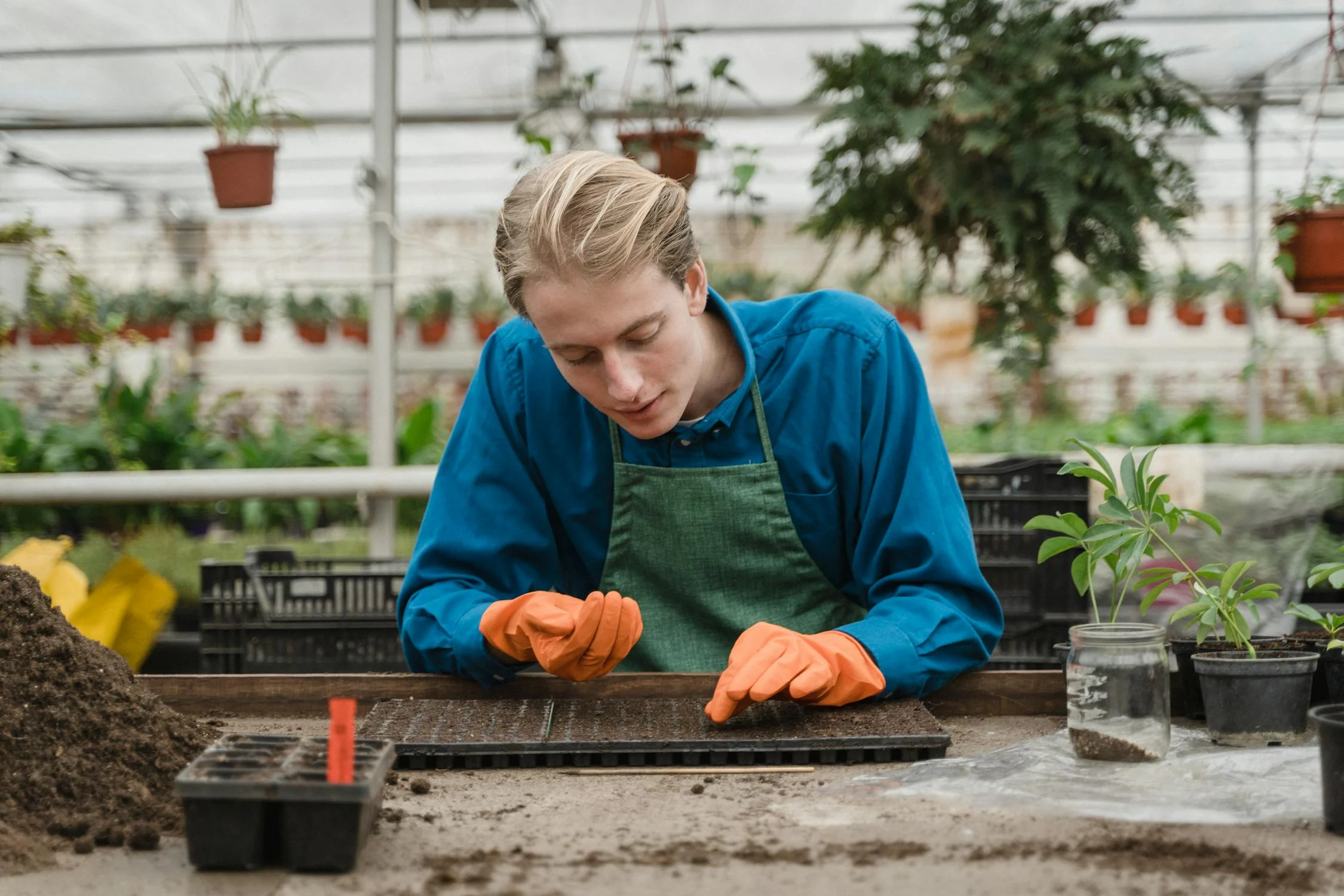
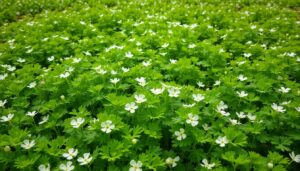
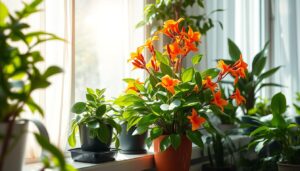







1 thought on “Grow Vibrant Indoor Lavender Plants: Tips & Care”